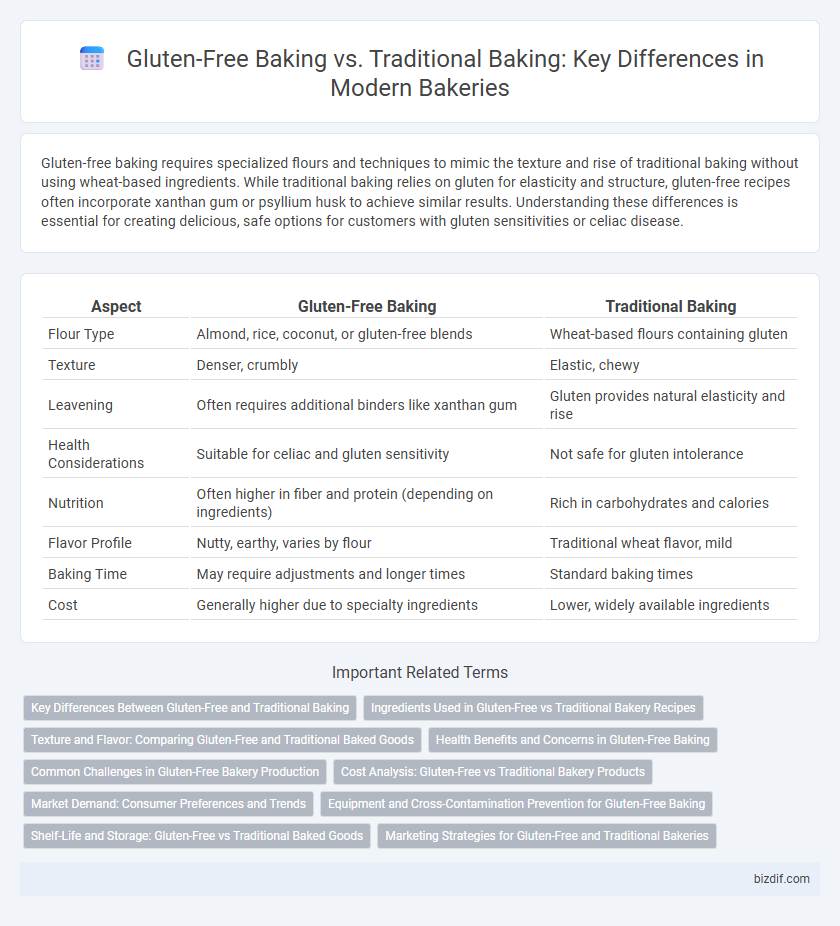Gluten-free baking requires specialized flours and techniques to mimic the texture and rise of traditional baking without using wheat-based ingredients. While traditional baking relies on gluten for elasticity and structure, gluten-free recipes often incorporate xanthan gum or psyllium husk to achieve similar results. Understanding these differences is essential for creating delicious, safe options for customers with gluten sensitivities or celiac disease.
Table of Comparison
| Aspect | Gluten-Free Baking | Traditional Baking |
|---|---|---|
| Flour Type | Almond, rice, coconut, or gluten-free blends | Wheat-based flours containing gluten |
| Texture | Denser, crumbly | Elastic, chewy |
| Leavening | Often requires additional binders like xanthan gum | Gluten provides natural elasticity and rise |
| Health Considerations | Suitable for celiac and gluten sensitivity | Not safe for gluten intolerance |
| Nutrition | Often higher in fiber and protein (depending on ingredients) | Rich in carbohydrates and calories |
| Flavor Profile | Nutty, earthy, varies by flour | Traditional wheat flavor, mild |
| Baking Time | May require adjustments and longer times | Standard baking times |
| Cost | Generally higher due to specialty ingredients | Lower, widely available ingredients |
Key Differences Between Gluten-Free and Traditional Baking
Gluten-free baking uses alternative flours such as almond, rice, or coconut flour instead of wheat flour, which lacks gluten proteins crucial for elasticity and structure in traditional baking. Traditional baking relies on gluten to create dough elasticity, chewy textures, and rise, while gluten-free recipes often use binding agents like xanthan gum or guar gum to mimic these properties. Moisture retention and texture differ significantly, with gluten-free baked goods tending to be denser and more crumbly compared to the lighter, airier consistency of traditional wheat-based products.
Ingredients Used in Gluten-Free vs Traditional Bakery Recipes
Gluten-free baking relies on alternative flours such as almond, coconut, rice, and tapioca starch, replacing wheat, barley, and rye flours used in traditional baking. Xanthan gum or guar gum often substitutes gluten to provide structure and elasticity, which are naturally present in gluten-containing grains. These ingredient differences significantly impact texture, moisture retention, and rise in gluten-free versus traditional baked goods.
Texture and Flavor: Comparing Gluten-Free and Traditional Baked Goods
Gluten-free baking often results in denser textures and slightly crumbly consistency due to the absence of gluten, which provides elasticity and structure in traditional baked goods. Flavor profiles in gluten-free products can vary, sometimes featuring nutty or earthy undertones from alternative flours like almond or coconut, contrasting with the familiar taste of wheat-based bakery items. Bakers frequently enhance moisture and binding agents to mimic the soft, chewy texture and rich flavor typical of traditional bread, cakes, and pastries.
Health Benefits and Concerns in Gluten-Free Baking
Gluten-free baking offers significant health benefits for individuals with celiac disease or gluten sensitivity by eliminating harmful gluten proteins that trigger immune responses or digestive issues. However, gluten-free products often lack essential nutrients such as fiber, iron, and B vitamins, which are commonly found in traditional wheat-based ingredients. Careful formulation using nutrient-rich alternative flours like almond, coconut, or buckwheat is essential to create balanced gluten-free baked goods that support overall health.
Common Challenges in Gluten-Free Bakery Production
Gluten-free bakery production faces common challenges such as achieving the desired texture and structure without the elasticity provided by gluten. Formulating gluten-free doughs requires precise combinations of alternative flours like rice, almond, or tapioca to prevent dryness and crumbly results. Cross-contamination is a critical concern, necessitating strict sanitation protocols to ensure products remain safe for individuals with celiac disease or gluten sensitivities.
Cost Analysis: Gluten-Free vs Traditional Bakery Products
Gluten-free baking generally incurs higher costs due to premium ingredients like almond flour, tapioca starch, and specialized binders that replace wheat gluten. Traditional baking benefits from widely available, lower-cost ingredients such as all-purpose flour and yeast, making bulk production more economical. The increased expense in gluten-free products often results in higher retail prices, reflecting the niche market and ingredient sourcing challenges.
Market Demand: Consumer Preferences and Trends
Growing consumer demand for gluten-free baking reflects increasing awareness of gluten intolerance and celiac disease, driving market growth significantly. Traditional baking maintains a strong presence due to established preferences and nostalgic appeal, but gluten-free products are rapidly expanding in supermarkets and specialty stores. Industry reports predict the gluten-free bakery segment will register a compound annual growth rate (CAGR) of over 10% in the next five years, highlighting shifting consumer trends.
Equipment and Cross-Contamination Prevention for Gluten-Free Baking
Gluten-free baking requires dedicated equipment such as separate mixers, baking trays, and utensils to prevent cross-contamination with gluten-containing ingredients commonly used in traditional baking. Establishing strict cleaning protocols and using color-coded tools further minimize the risk of gluten exposure, ensuring the safety of gluten-intolerant consumers. Proper storage and clearly labeled ingredients also play a crucial role in maintaining a gluten-free baking environment.
Shelf-Life and Storage: Gluten-Free vs Traditional Baked Goods
Gluten-free baked goods typically have a shorter shelf life than traditional baked products due to the absence of gluten, which helps retain moisture and structure. Storage methods for gluten-free items often require airtight containers and refrigeration to prevent dryness and spoilage. Traditional baked goods benefit from gluten's elasticity, allowing for longer room-temperature storage without significant texture or freshness loss.
Marketing Strategies for Gluten-Free and Traditional Bakeries
Marketing strategies for gluten-free bakeries emphasize health-conscious messaging, targeting consumers with gluten intolerance or celiac disease by highlighting allergen-free ingredients and certifications. Traditional bakeries focus on sensory appeal and artisanal craftsmanship, promoting classic flavors and textures through in-store sampling and nostalgia-driven campaigns. Both sectors leverage social media campaigns and influencer partnerships to build brand trust and increase customer engagement.
Gluten-free baking vs Traditional baking Infographic

 bizdif.com
bizdif.com